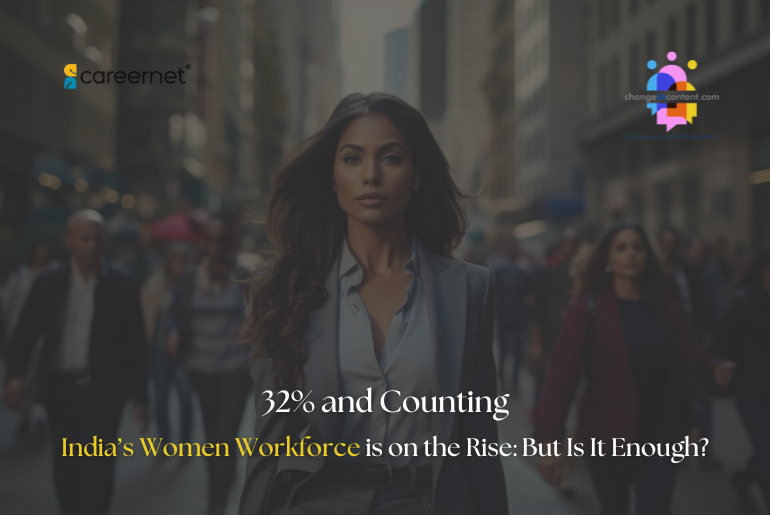The Indian job market is slowly but surely changing. This time, women are at the centre of it. According to Careernet’s latest report, The State of Women’s Employment in India, women’s placement in India has climbed by 6 percentage points over the last six years. It has moved from 26% in 2019 to an encouraging 32% in 2024. It marks the highest female representation in Careernet’s placement data since it began tracking this trend.
What does this mean for India’s gender-diverse workplace dreams? Is this a moment to celebrate or a milestone that simply sets the stage for more? As this data shows, progress is happening — but in pockets, sectors, and cities. The real victory will come when this inclusivity spreads across levels, industries, and geographies.
Women’s placement trends: What the data says
The most significant takeaway? One in every three candidates placed by Careernet in 2024 is a woman. It is not only the highest representation in six years but also a trend that has stayed consistent over the past two years. It is a promising sign of sustained momentum rather than a one-off spike.
Sector-wise, BFSI Global Capability Centres (GCCs) have led the charge in women hiring. The numbers have gone from 40% in 2022 to 44% in 2024. Other domain GCCs, too, have maintained a strong demand for women talent. It proves that high-growth sectors are no longer hesitant to place women at the forefront.
Cities fueling the women’s placement shift
In terms of geography, Bengaluru (32%), Delhi/NCR (28%), and Hyderabad (27%) top the list of cities where women hiring is gaining traction in 2024. Interestingly, Delhi/NCR has seen a notable jump from just 20% in 2023 to 28% in 2024. On the flip side, Mumbai lags behind other Tier-I cities, recording just 25% of female placements.
Another welcome shift? Tier-II and other cities have seen a 5 percentage point increase in women’s placement over the last three years, reflecting a decentralisation of opportunities that could help more women build careers outside metros.
Sectors stepping up (and slowing down)
Startups are stepping up. The report shows a 9-percentage-point rise in women hiring from 2022 to 2024. It is a sign that the startup ecosystem is finally taking inclusion seriously. Meanwhile, IT services maintained a steady 29–30% hiring rate for women, suggesting consistent gender diversity efforts.
However, domestic enterprises saw a 5-percentage-point drop in women hiring in 2024 compared to the year before. It is a red flag for an otherwise optimistic report.
Experience levels: The freshers vs. leadership story
The report reveals a subtle imbalance. While freshers dominate the hiring pipeline, their share dropped by about 2% this year. Mid-level women hires (3–12 years of experience) have remained steady, hovering between 23–27%. But the real challenge? Senior-level women hires (12+ years) still hover around 19%. Although that is a 2-point rise from 2022, it underscores the uphill climb women still face when transitioning to leadership roles.
Conclusion: Women’s placement is rising, but where are the leadership roles?
Despite the 6-point surge in women’s placement, the hard truth is that the ladder narrows sharply the higher women climb. The top looks emptier than the bottom, and until the hiring ecosystem embraces equitable growth across all levels, real inclusion will remain incomplete.
Changeincontent perspective: More than just progress – We need presence
At Changeincontent, we celebrate this momentum — but with caution. Numbers tell us one part of the story but not the full one. This jump in women’s placement is a hopeful headline but also a mirror. It reflects where efforts are being made and, more importantly, where they are not.
Progress in Tier-II cities, a rise in startup participation, and leadership interest in inclusion are promising shifts. But senior roles still lack women. Mid-career burnout is still high. And women still bear the disproportionate burden of integration, not just balance.
As we move forward, let us not wait for another symbolic Women’s Day to ask the hard questions. Let us normalise asking them every day. That is why we continue to stand by our #NoWomensDay campaign — because inclusion cannot be seasonal. It must be structural.
Disclaimer: The views expressed in this article are based on the writer’s insights, supported by data and resources available both online and offline, as applicable. Changeincontent.com is committed to promoting inclusivity across all forms of content. We broadly define inclusivity as media, policies, law, and history—encompassing all elements that influence the lives of women and marginalised individuals. Our goal is to promote understanding and advocate for comprehensive inclusivity.


